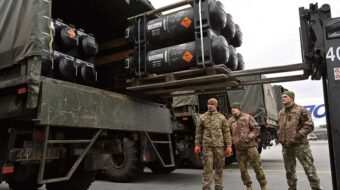
The follies of U.S. plans for war and more war are being exposed now by Brazilian President Luiz Inácio Lula da Silva during his current visit to China.
On Friday, the day that the Washington Post reported the U.S. is planning to continue pouring weapons into the Ukraine war well into next year, Lula is in China backing that country’s peace plan for Ukraine by calling for an immediate ceasefire and negotiations.
China’s Foreign Minister Qin Gang declared Thursday that his country supports that approach and will send no weapons to either side in the Ukraine war. The U.S., simultaneously, was busy carving military landing strips in the jungles of Tinian, a small Pacific island, to be used against China if it makes any moves to claim its own territory—the island of Taiwan.
The military airstrips are close to where the U.S. launched the bombers that carried the atomic bombs dropped during WWII on the people of Japan.
U.S. militarization of Asia is driven by the increasing economic importance of the region, upon which both the U.S. and Europe have become dependent. In the view of powerful capitalist interests in the U.S., the region now needs to be controlled by the West militarily and economically. Hence the efforts by the U.S. to drive a wedge between Europe and China, just as it drove a wedge between Europe and Russia.
The U.S.’ anti-China and anti-Russia policies—along with the sanctions and threats of sanctions against them—have put the two countries in a position of shared resistance.
At the same time that Chinese President Xi Jinping visited Russia recently, Japan’s leadership was in Kiev, reflecting that the U.S., as it did with Germany in Europe, is pushing Japan to get involved in military activity against China and Russia.
Both Germany and Japan have been encouraged to give up their post-WWII pacifism and trade it in for militarization—with Germany’s armed forces turned eastward toward Russia and Japan’s against China.
The public in both Germany and Japan, remembering the horrors of fascism in the last century, has not been as quick as the U.S. would like in trading pacifism for war preparation. Peace demonstrations in both countries are growing larger by the week.
In addition to supporting China’s peace plan for Ukraine, Lula is joining with Beijing in a strong push to eliminate U.S. economic penetration of the entire global South. Some of the most powerful action that can be taken against U.S. control of the Asia-Pacific region is, in Lula’s eyes, economic action.
Key to this are efforts by Brazil and China to end the global South’s reliance on the U.S. dollar in trade and other financial transactions.
The two countries have agreed to carry out bilateral trade in their own currencies and ditch the dollar. Work is now underway on developing a new currency for the global South.
The New Development Bank, based in Shanghai, will play a major role in this process. Former Brazilian President Dilma Rousseff, a close adviser to Lula, just became the bank’s new head, and her successor attended her swearing-in during his visit on Thursday.
The institution will provide an alternative to the U.S.-controlled International Monetary Fund and World Bank, being focused on the BRICS group of developing nations—Brazil, Russia, India, China, and South Africa.
Some 99 loan projects have already been issued by the new bank, totaling $34 billion in new infrastructure.
“The New Development Bank is the product of a partnership among BRICS countries with a view to creating a world with less poverty, less inequality, and more sustainability,” Lula said on Thursday.
The efforts by Brazil and China to end the global South’s reliance on the U.S. dollar is not just in trade but in many other financial transactions, the Chinese and Brazilians say.
During his meeting with Xi Friday, Lula is also discussing investment, reindustrialization, energy transition, climate change, and peace agreements, according to the Brazilian government.
“As comprehensive strategic partners, China and Brazil share extensive common interests,” Xi said, according to information about the meeting released by the Chinese Foreign Ministry.
China is Brazil’s biggest export market, each year buying tens of billions of dollars of soybeans, beef, iron ore, poultry, pulp, sugar cane, cotton, and crude oil. Brazil is Latin America’s biggest recipient of Chinese investment, according to Chinese media.
One of the at least 20 bilateral agreements that Lula has signed in China already is for the construction of a sixth satellite under a binational program to monitor conservation and illegal logging in areas such as the Amazon. Under former President Jair Bolsonaro, the rainforest saw significant deforestation by the right-wing leader’s corporate allies.
When discussing the ceasefire and negotiations to end the Ukraine war, Lula saw the U.S., Russia, and Ukraine as all having shared responsibility for ending the war.
He said Ukraine should consider offering to relinquish its claims on Crimea which has a majority Russian, not Ukrainian, population. Before Russia’s invasion, Ukrainian President Zelensky had said that the status of Crimea and even other Russian ethnic-majority areas were negotiable.
Subsequently, Britain and the U.S. signaled “not so fast” to Kiev and increased the seemingly endless military aid being shipped to Ukraine. Zelensky, though he has previously expressed interest in China’s plan for a ceasefire, now says ideas such as the proposal by Lula are unacceptable.
In any case, Lula said there has never been a war in which a ceasefire and negotiations were an unreasonable approach. He turned down requests by the U.S. that he send weapons to Ukraine, saying he was interested instead in working for peace.
Lula is putting Brazil at the heart of issues crucial to the whole planet. The Asia-Pacific region is home to 60% of the world’s population and accounts for 65% of the world’s gross domestic product.
This is something too important for imperialism to pass up and explains why the U.S. military, NATO, and the Pentagon want to focus on this region—in addition to Europe, Ukraine, and Russia.
Roger McKenzie contributed to this article.
We hope you appreciated this article. Before you go, please support great working-class and pro-people journalism by donating to People’s World.
We are not neutral. Our mission is to be a voice for truth, democracy, the environment, and socialism. We believe in people before profits. So, we take sides. Yours!
We are part of the pro-democracy media contesting the vast right-wing media propaganda ecosystem brainwashing tens of millions and putting democracy at risk.
Our journalism is free of corporate influence and paywalls because we are totally reader supported. At People’s World, we believe news and information should be free and accessible to all.
But we need your help. It takes money—a lot of it—to produce and cover unique stories you see in our pages. Only you, our readers and supporters, make this possible. If you enjoy reading People’s World and the stories we bring you, support our work by donating or becoming a monthly sustainer today.












Comments